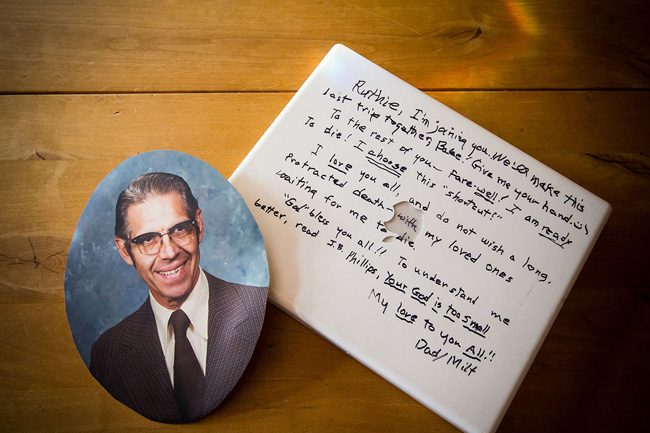
Lethal Crisis: When Seniors Turn To Suicide
When Larry Anders moved into the Bay at Burlington nursing home in late 2017, he wasn’t supposed to be there long. At 77, the stoic Wisconsin machinist had just endured the death of his wife of 51 years and a grim new diagnosis: throat cancer, stage 4.
His son and daughter expected him to stay two weeks, tops, before going home to begin chemotherapy. From the start, they were alarmed by the lack of care at the center, where, they said, staff seemed indifferent, if not incompetent — failing to check on him promptly, handing pills to a man who couldn’t swallow.
Anders never mentioned suicide to his children, who camped out day and night by his bedside to monitor his care.
But two days after Christmas, alone in his nursing home room, Anders killed himself. He didn’t leave a note.
The act stunned his family. His daughter, Lorie Juno, 50, was so distressed that, a year later, she still refused to learn the details of her father’s death. The official cause was asphyxiation.
“It’s sad he was feeling in such a desperate place in the end,” Juno said.
In a nation where suicide continues to climb, claiming more than 47,000 lives in 2017, such deaths among older adults — including the 2.2 million who live in long-term care settings — are often overlooked. A six-month investigation by Kaiser Health News and PBS NewsHour finds that older Americans are quietly killing themselves in nursing homes, assisted living centers and adult care homes.
Poor documentation makes it difficult to tell exactly how often such deaths occur. But a KHN analysis of new data from the University of Michigan suggests that hundreds of suicides by older adults each year — nearly one per day — are related to long-term care. Thousands more people may be at risk in those settings, where up to a third of residents report suicidal thoughts, research shows.
Each suicide results from a unique blend of factors, of course. But the fact that frail older Americans are managing to kill themselves in what are supposed to be safe, supervised havens raises questions about whether these facilities pay enough attention to risk factors like mental health, physical decline and disconnectedness — and events such as losing a spouse or leaving one’s home. More controversial is whether older adults in those settings should be able to take their lives through what some fiercely defend as “rational suicide.”
Tracking suicides in long-term care is difficult. No federal regulations require reporting of such deaths and most states either don’t count — or won’t divulge — how many people end their own lives in those settings.
Briana Mezuk, an associate professor of epidemiology at the University of Michigan, found in 2015 that the rate of suicide in older adults in nursing homes in Virginia was nearly the same as the rate in the general population, despite the greater supervision the facilities provide.
In research they presented at the 2018 Gerontological Society of America annual meeting, Mezuk’s team looked at nearly 50,000 suicides among people 55 and older in the National Violent Death Reporting System (NVDRS) from 2003 to 2015 in 27 states. They found that 2.2% of those suicides were related to long-term care. The people who died were either people living in or transitioning to long-term care, or caregivers of people in those circumstances.




























ASF says
An important article to read, even though it is a very difficult thing to think about. None of us–or our loved ones–is immune from the vagaries of human existence.
CB from PC says
You know what else drives Seniors to suicide?
Indifference by, and lack of interaction with others.
Seniors lived lives before Twitter and Facebook.
We learned to fix our own stuff because we had no money to buy new, or pay someone to repair it.
We rode bicycles and played fast pitch hardball without helmets as kids…no trophies just for showing up, or T ball.
We rode in cars without seat belts.
We did complex calculations using a slide rule in high school.
We souped up our cars and motorcycles to beat the other guy’s.
Tried to get our basement bands to sound like the Stones or Byrds.
Later, many of us fought in Wars on foreign soil, and gave our lives, or watched a friend die.
All this before starting families and careers.
So…the next time you see some elderly person, remember they may have a story which will make the events in your young life seem insignificant.
Believe it or not, they still have some fuel in the tank untainted by the Political Correctness BS of today.
Kat says
An article that all need to read. We should remember to check on our neighbors. Be kind to one another
palmcoaster says
Thank you FL for this excellent editorial!
ken says
Thank you for a thoughtful article on an important topic.
capt says
Remember and assist the elderly, One day you yourself could be in the same situation
anonymous says
CB , well said I feel the same way every senior is a history book.
For real says
Thank you, CB, for your insightful comments. I work as a caregiver for the elderly. What they need, besides meeting their physical necessities, is to be heard and validated. I can’t begin to tell you how important being heard is to an older person. Listen to the stories, their recounting of history as they remember it, and watch how their faces come alive. It is an honor I am grateful for.
Richard says
The suicide rate would drop dramatically if every state in this country had a Death with Dignity Law. I know one person who moved to Oregon to set up residency just because of her terminal cancer as she did not want to suffer the excruciating pain and discomfort while wasting away from the cancer ravaging her body.